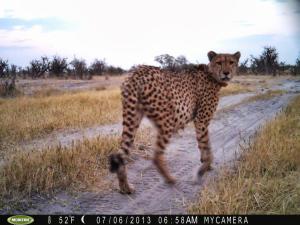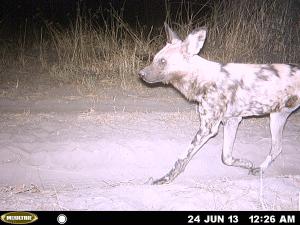Lindsey N. Rich
This research represents the pilot study of a multi-year project to identify and implement a sustainable method for monitoring multiple, sympatric carnivores across landscape scales in Botswana.
Northern Botswana has one of the highest diversities of carnivores in Africa yet currently, there is no landscape scale monitoring of carnivores and knowledge of many carnivore species is lacking. As a result, the overall goal of our multi-year project is to identify and implement a sustainable method for monitoring multiple, sympatric carnivores across landscape scales in Botswana. Information on the distributions, demographics, and ecology of Botswana’s carnivore populations will assist in the development of effective biodiversity conservation measures. Conservation measures are pertinent due to recent reports of declining wildlife populations, increasing pressures from illegal hunting, and large scale changes in land use and management policies.

Cheetah.
To achieve our goal we will compare two, independent carnivore survey methods: spoor and camera trap surveys. Spoor surveys are often the preferred method for monitoring wildlife in Africa yet their ability to detect changes in the distribution and abundance of carnivore populations remains largely unknown. To determine the efficacy of spoor surveys, we will compare them to camera trap surveys. Camera traps have been used extensively for elusive carnivores in other parts of the world, but to date, have rarely been employed following systematic, standardized protocols in Africa.

Wild dog.
Our research will be carried out in 4 study areas, each spanning ~200km2, representing different levels of protection/land use, ranging from livestock grazing to a fully protected wildlife reserve. This will allow analyses of how individual carnivore species and carnivore communities are influenced by varying levels of human land use practices.
To achieve our overall goal, we have 3 main objectives:
1) Determine overall carnivore richness in northern Botswana and assess the ecological factors (e.g., land cover, human impact, and prey density) underlying occupancy and detection of sympatric meso- and large carnivores. Ecological factors found to be important can be used to predict the impact of environmental or land use changes on carnivore communities.
2) Estimate the density of sympatric meso- and large carnivores using camera trap surveys. We will attempt to estimate the density of 5 large carnivores (leopard, lion, cheetah, African wild dog, and spotted hyena) and 9 meso-carnivores (aardwolf, bat-eared fox, black-backed jackal, caracal, civet, honey badger, serval, side-striped jackal, and wild cat).
3) Evaluate the efficacy of spoor surveys for monitoring the distribution and population trends of large carnivores. We will compare occupancy estimates from spoor surveys to density estimates from camera trap surveys.